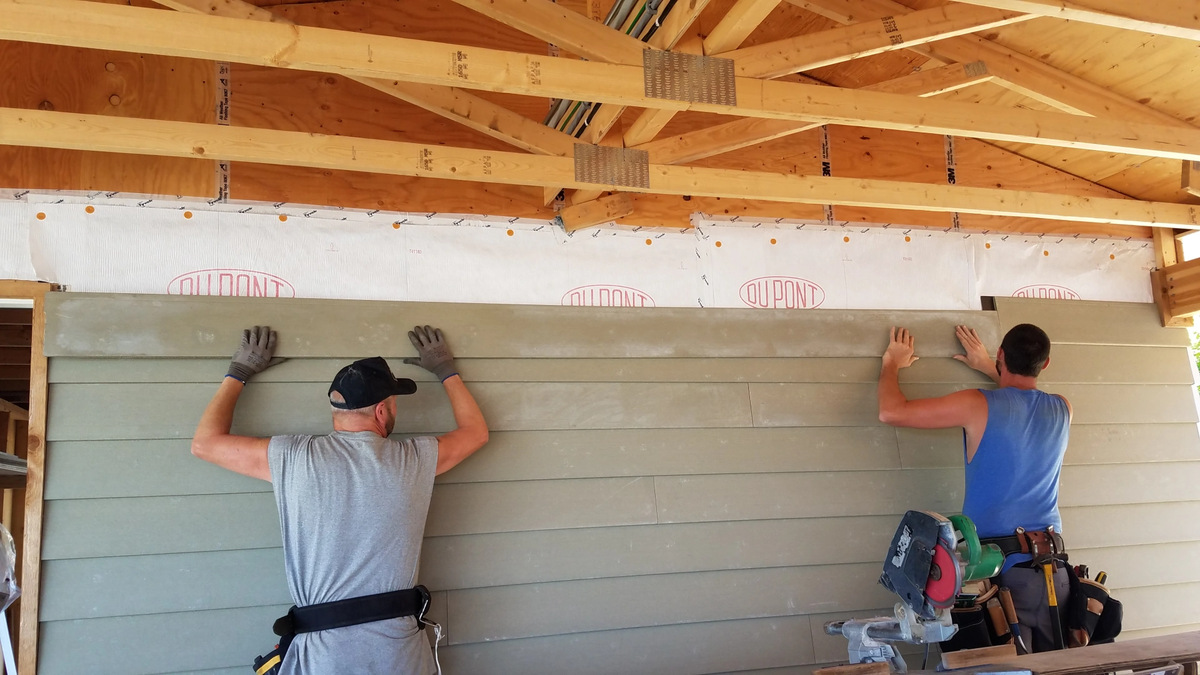

Articles
How To Bid A Siding Job
Modified: August 31, 2024
Learn the essential steps to successfully bid a siding job with our informative articles. Gain insights, tips, and expert advice to ensure your bid is competitive and profitable.
(Many of the links in this article redirect to a specific reviewed product. Your purchase of these products through affiliate links helps to generate commission for Storables.com, at no extra cost. Learn more)
Introduction
Welcome to the world of siding jobs! If you’re in the business of construction or home improvement, bidding on a siding job can be a lucrative opportunity. However, it can also be a daunting task, especially if you’re unfamiliar with the process. In this article, we will guide you through the steps to effectively bid a siding job.
First, it’s important to understand that bidding a siding job is not just about quoting a price. It requires careful assessment, estimation, and calculation to provide an accurate and competitive bid. By following these steps, you can ensure that your bid covers all the necessary costs and ensures a profitable margin.
So, let’s dive into the process and learn how to bid a siding job like a pro!
Key Takeaways:
- Thoroughly assess the project, estimate materials and labor costs, factor in other expenses, and create a professional bid proposal to increase your chances of winning a siding job bid.
- By factoring in a reasonable profit margin, showcasing professionalism, and delivering high-quality work, you can establish a positive reputation and increase future opportunities in the siding job bidding process.
Read more: How To Bid Plumbing Jobs
Step 1: Assessing the Project
Before you can bid on a siding job, it’s essential to assess the project thoroughly. This step will help you gather all the necessary information to make an accurate estimate and determine the scope of work required.
Start by conducting a site visit to the property. Observe the condition of the existing siding, the architectural style, and any unique features that may affect the installation process. Take measurements of the area that needs to be covered with siding, paying attention to windows, doors, and any other obstacles.
During the assessment, identify any repairs or preparation work that needs to be done prior to installing the new siding. This can include removing old siding, repairing damaged surfaces, or addressing any underlying structural issues. It’s crucial to account for these additional tasks in your bid.
Furthermore, consider the type of siding materials that the client wants. There are various options available, such as vinyl, wood, fiber cement, or metal siding. Each material has different costs, installation requirements, and maintenance needs. Discuss the pros and cons of each option with the client to determine their preferences.
Additionally, take note of any specific design elements or customization requested by the client. This can include trim work, decorative patterns, or special features. These details can impact the complexity of the project and should be factored into your bid.
Lastly, thoroughly understand the timeline and any deadlines associated with the project. This will help you plan your manpower and resources effectively and ensure timely completion.
After assessing the project, you should have a clear understanding of the requirements and challenges involved. This information will be instrumental in the next steps of estimating materials, calculating labor costs, and determining other expenses.
Step 2: Estimating Materials
Once you have assessed the project, the next step in bidding a siding job is to estimate the materials required. Accurate material estimation is crucial to avoid overestimating or underestimating the costs.
Start by determining the square footage of the area that needs to be covered with siding. Multiply the length and height of each wall to find the total square footage. This will serve as the basis for calculating the amount of siding material needed.
Next, consider the type of siding material chosen by the client. Different materials come in different dimensions and have different coverage capabilities. Check the manufacturer’s specifications to determine the coverage per square foot for the chosen siding material.
Based on the square footage and coverage per square foot, calculate the total quantity of siding material needed. It’s always a good idea to add a buffer of around 10% to account for waste, mistakes, or future repairs.
Don’t forget to consider other necessary materials such as insulation, underlayment, nails, caulking, and trim. These additional materials should be included in your estimation to provide a comprehensive and accurate bid.
Research the prices of the materials from local suppliers to determine the cost per unit. Multiply the quantity of each material by its respective cost to calculate the total material cost for the project.
Estimating materials requires attention to detail and knowledge of the specific requirements of the project. Make sure to communicate with the client to confirm their preferences, any specific brand choices, or additional material requirements before finalizing your estimates.
By accurately estimating the materials required for the siding job, you will have a solid foundation for the next steps of calculating labor costs and determining other expenses, ensuring a well-rounded and competitive bid.
Step 3: Calculating Labor Costs
Calculating labor costs for a siding job is an essential step in accurately bidding on the project. Labor costs typically make up a significant portion of the overall project expenses, so it’s crucial to estimate them carefully.
Start by determining the number of labor hours required for the project. Consider factors such as the complexity of the installation, the size of the crew, and the experience level of the workers. Break down the project into specific tasks, such as removing old siding, preparing surfaces, installing the new siding, and any additional custom work.
Once you have a clear breakdown of the tasks, estimate the number of hours each task will take. Consider various factors such as the skill level required, access to the work area, and any potential challenges that may arise.
Next, determine the labor rate for your crew. This can vary depending on factors such as the location, the skill level of the workers, and the industry standards. Research the average labor rates in your area and adjust accordingly based on the skills and experience of your team.
Multiply the estimated labor hours by the labor rate to calculate the total labor cost for the project. It’s important to include overhead costs such as insurance, taxes, and any other expenses related to employing the crew in your calculations.
Keep in mind that unforeseen circumstances or additional tasks may arise during the project. It’s essential to have a contingency plan and include a buffer in your labor cost estimation to accommodate any unexpected work.
Communicate with your team and consider their input when estimating labor costs. Their experience and expertise can provide valuable insights and ensure a more accurate bid.
By carefully calculating labor costs, you can provide a fair and competitive bid that covers your expenses while also factoring in a reasonable profit margin. This will help you build trust with your client and increase the chances of winning the siding job.
Step 4: Determining Other Expenses
In addition to material and labor costs, there are other expenses that you need to consider when bidding on a siding job. These expenses can significantly impact the overall profitability of the project, so it’s essential to calculate them accurately.
One important factor to consider is equipment and tool costs. Assess the tools and equipment needed for the project, such as scaffolding, ladders, cutting tools, and safety equipment. Determine if you already have these items or if you need to rent or purchase them. Research the rental or purchase costs and include them in your bid accordingly.
Transportation expenses should also be taken into account. Consider the distance to the project site, fuel costs, and any additional transportation expenses that may arise during the project. Calculate the total transportation costs and factor them into your bid.
Subcontractor costs may also be necessary depending on the scope of the project. If you need to hire subcontractors for specialized tasks such as electrical work or window installation, obtain quotes from reliable subcontractors and include their estimated costs in your bid.
Permits and licensing fees should not be overlooked. Research the permits required for the siding project and their associated costs. Factor these fees into your bid to ensure compliance with local regulations.
Insurance costs are another factor to consider. Ensure that you have proper liability insurance coverage for the project and reflect the insurance costs in your bid. This will provide peace of mind for you and your client, demonstrating professionalism and protecting against any potential accidents or damages.
Lastly, don’t forget to include any miscellaneous expenses that may arise during the project. These can include disposal fees for old siding material, cleaning supplies, or other miscellaneous costs specific to the project.
By accurately determining these additional expenses, you can account for all the costs associated with the siding job and present a comprehensive and transparent bid to your client.
When bidding a siding job, make sure to accurately measure the area to be covered, consider the type of siding material, and factor in any additional costs for trim, insulation, and labor.
Read more: How To Bid On Landscaping Jobs
Step 5: Factoring in Profit Margin
One crucial aspect of bidding on a siding job is factoring in a profit margin. As a business owner, it’s essential to ensure that your bid covers not only the project expenses but also allows for a reasonable profit.
When determining your profit margin, consider various factors such as your business overhead costs, desired return on investment, and market competition. It’s important to strike a balance between offering a competitive bid and maintaining profitability.
Start by considering your business overhead costs, including office rent, utilities, insurance, and administrative expenses. These costs need to be covered by the profit margin to ensure the sustainability of your business.
Next, determine your desired return on investment. This will depend on several factors, such as your business goals, the level of risk involved, and the market conditions. Assess the profitability of similar projects you have completed in the past and adjust your profit margin accordingly.
Market competition is another factor to consider when setting your profit margin. Research the prices offered by competitors for similar siding projects. While it’s important to be competitive, ensure that your profit margin is sufficient to cover your expenses and generate a reasonable profit.
Factoring in a profit margin is not just about increasing the price; it’s about assessing the value you bring to the project. Consider the quality of your work, your expertise, and the level of service you provide. Your bid should reflect the value you bring to the client and justify the higher price.
Communicate with the client and be transparent about the breakdown of costs in your bid. This will show professionalism and build trust, ensuring that the client understands the value in the pricing.
It’s important to strike a balance between a competitive bid and a profitable margin. Remember, a fair profit allows you to sustain your business, invest in growth, and continue offering high-quality services to your clients.
By factoring in a reasonable profit margin, you can ensure the financial success of your business while delivering a competitive bid that meets the client’s expectations.
Step 6: Creating a Bid Proposal
Creating a comprehensive and professional bid proposal is the next step in the process of bidding on a siding job. A well-crafted bid proposal showcases your professionalism and conveys to the client that you understand their needs and can deliver a successful project.
Start by organizing the bid proposal in a clear and structured format. Include a cover page with your company name, logo, and contact information. This creates a professional image and helps the client easily identify your bid.
Next, provide a detailed description of the project, outlining the scope of work to be done. Include specific tasks such as removal of old siding, surface preparation, installation of new siding, and any additional customization or repairs.
Incorporate the measurements and calculations from the assessment phase, including the area to be covered, material quantities, and labor hours required. Clearly outline the type of siding material chosen by the client, as well as any additional materials such as insulation or trim. This demonstrates thoroughness and attention to detail.
Present a breakdown of the costs, including material costs, labor costs, and any other expenses identified in the previous steps. Be transparent in your pricing, explaining how you arrived at the figures and providing a clear overview of each cost category.
Include a timeline for the project, specifying the start date, estimated completion date, and any milestones or deadlines along the way. This helps the client understand the project timeline and aids in their decision-making process.
Consider including references or testimonials from past clients to showcase your expertise and reliability. This adds credibility to your bid and instills confidence in the client that they are choosing the right contractor for the job.
Lastly, include a section that outlines your terms and conditions, such as payment terms, warranty information, and any necessary contractual agreements. Clearly communicate your expectations and ensure that both parties are on the same page.
Before submitting the bid proposal, thoroughly review it for accuracy, clarity, and professionalism. Check for any typos or errors that may reflect poorly on your attention to detail. Your bid proposal serves as a representation of your brand, so make sure it leaves a positive and lasting impression.
By creating a well-structured and professional bid proposal, you increase your chances of standing out from the competition and winning the siding job. It shows your commitment to excellence and provides the client with confidence and assurance in your capabilities.
Step 7: Reviewing and Finalizing the Bid
The final step in bidding on a siding job is reviewing and finalizing the bid before submission. This critical step ensures that your bid is accurate, competitive, and aligns with the client’s expectations.
Start by conducting a thorough review of the bid proposal. Double-check all the calculations, including material quantities, labor costs, and other expenses. Ensure that your pricing is reasonable and in line with market rates while still allowing for a profitable margin.
Review the scope of work and make sure that all the client’s requirements, customization requests, and necessary repairs are clearly addressed in the bid. Pay attention to detail and ensure that nothing is overlooked.
Consider the overall presentation of the bid proposal. Is it well-organized and easy to understand? Are there any sections that need clarification or further elaboration? Make necessary revisions to enhance the clarity and professionalism of the bid.
Step into the shoes of the client and consider their perspective. Does the bid proposal clearly communicate the value and benefits of choosing your company for the project? Is there anything that can be added or revised to better showcase your expertise and competitive edge?
Ensure that the final bid proposal reflects any discussions or negotiations you have had with the client. If there were specific requests or changes made during the bidding process, make sure they are accurately reflected in the final proposal.
Before submitting the bid, take the time to review it one last time for any errors or typos. A polished and error-free bid proposal demonstrates professionalism and attention to detail.
Once you are satisfied with the final bid, prepare it for submission to the client. Consider the preferred method of submission, whether it’s through email, in person, or through a formal bid submission process.
Take note of any deadlines for bid submissions and ensure that your bid is submitted on time. Late submissions may not be considered, so it’s crucial to adhere to the specified timeline.
After submitting the bid, follow up with the client to confirm receipt and address any questions or concerns they may have. This demonstrates your commitment and responsiveness.
By thoroughly reviewing and finalizing your bid, you increase your chances of success in winning the siding job. A well-prepared and professional bid showcases your expertise and convinces the client that you are the right contractor for their project.
Conclusion
Bidding on a siding job requires a systematic approach, attention to detail, and a thorough understanding of the project requirements. By following the steps outlined in this article, you can effectively bid on a siding job and increase your chances of success.
Assessing the project allows you to gather all the necessary information, take measurements, and identify any additional tasks or challenges. Estimating materials involves calculating the square footage, determining the type of siding material, and accurately estimating the quantity and cost of materials needed.
Calculating labor costs involves breaking down the project into specific tasks, estimating the labor hours required, and determining the labor rate. Including other expenses such as equipment costs, transportation, permits, and subcontractor fees ensures that your bid covers all the necessary expenses.
Factoring in a reasonable profit margin ensures that your bid is financially sustainable and reflects the value you bring to the project. Creating a comprehensive bid proposal showcases your professionalism, communicates the scope of work, and provides a clear breakdown of costs, timeline, and terms.
Reviewing and finalizing the bid is essential to ensure accuracy, clarity, and professionalism. Double-checking all calculations, addressing any client requirements, and polishing the proposal before submission increases your chances of standing out and winning the siding job.
Remember, building a strong relationship with the client through effective communication, transparency, and professionalism is essential. By providing competitive and comprehensive bids, delivering high-quality work, and exceeding client expectations, you can establish a positive reputation and increase future opportunities.
As you embark on your next siding job bid, keep these steps in mind, adapt them to your specific situation, and refine your approach with each new project. With practice and experience, you’ll become a confident bidder, ready to take on any siding job that comes your way.
Frequently Asked Questions about How To Bid A Siding Job
Was this page helpful?
At Storables.com, we guarantee accurate and reliable information. Our content, validated by Expert Board Contributors, is crafted following stringent Editorial Policies. We're committed to providing you with well-researched, expert-backed insights for all your informational needs.















0 thoughts on “How To Bid A Siding Job”